 Ofcom has recently published a leaflet outlining how mobile subscribers can go about maximising their mobile signal with a view to getting the best possible coverage. The leaflet covers issues such as checking coverage first, before buying a phone (shops have on-line coverage checkers available), trying out different operators (by testing different SIM cards) and has a few technical measures such as the use of Femtocells (tiny mobile base stations you can install in your own home) and UMA (carrying your voice traffic over WiFi when you're in the coverage of a suitable hotspot).
Ofcom has recently published a leaflet outlining how mobile subscribers can go about maximising their mobile signal with a view to getting the best possible coverage. The leaflet covers issues such as checking coverage first, before buying a phone (shops have on-line coverage checkers available), trying out different operators (by testing different SIM cards) and has a few technical measures such as the use of Femtocells (tiny mobile base stations you can install in your own home) and UMA (carrying your voice traffic over WiFi when you're in the coverage of a suitable hotspot).This is all well and good, and reasonable advice, but it doesn't cover how you might go about getting a better signal if you are stuck in an area with poor coverage. So here's the (new look!) Wireless Waffle guide to practical things you can do to get a better signal (and things that don't work).
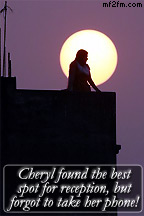 Get high! By far the best way to improve your chances of getting a good signal is to get your phone as high as possible. Signals upstairs will be better than signals downstairs. Signals at the top of a hill will be better than at the bottom. Standing on the roof of your car will get a better signal than sitting inside it (not recommended if you are a bit on the heavy side). Height is the number one way to boost your signal.
Get high! By far the best way to improve your chances of getting a good signal is to get your phone as high as possible. Signals upstairs will be better than signals downstairs. Signals at the top of a hill will be better than at the bottom. Standing on the roof of your car will get a better signal than sitting inside it (not recommended if you are a bit on the heavy side). Height is the number one way to boost your signal.Get out! The Ofcom paper mentions this too, but doesn't point out how big a difference it can make. Buildings can shield mobile signals by anything up to a factor of 50. Standing outside will circumvent this shielding and can make a big difference in your chances of success.
Get moving! Buildings not only shield signals inside them but can block signals from passing through them. Other big obstructions such as gasometers, walls, and even trees and cars
can also block signals. As you are unlikely to know which direction the mobile signal you are trying to receive is coming from, you may inadvertently be stood in a position where it is being blocked. Move around (in particular walk around a building) whilst checking the signal on your phone to see if there is a spot where it suddenly comes to life.
 Get naked! Whilst we would love to see people walking around buildings in the nude to try and get a better phone signal, by this we mean taking off any covers, shells or other accoutremenets which adorn your phone. Some covers can contain metal elements which can deflect mobile signals, especially if they end up covering up the antenna on your phone. Operating your phone 'naked' will ensure that it's antenna is not blocked or covered in any way and can further improve performance.
Get naked! Whilst we would love to see people walking around buildings in the nude to try and get a better phone signal, by this we mean taking off any covers, shells or other accoutremenets which adorn your phone. Some covers can contain metal elements which can deflect mobile signals, especially if they end up covering up the antenna on your phone. Operating your phone 'naked' will ensure that it's antenna is not blocked or covered in any way and can further improve performance.Get clear! Most electrical devices, especially computers, TVs, set top boxes and other electronic gizmos give off weak radio interference. The amount they give off is limited by law, but in close proximity it can be enough to upset mobile reception. Make sure you are as far as possible away from any electronic equipment and the interference they generate should be too weak to cause reception problems.
Get plugged in! If your phone has option to connect an external antenna (such as via a car-kit) it might be feasible to connect an free-standing aerial (such as these) to it. The antennas inside phones are a compromise in size, designed to peform as well as possible given the small space in which they have to fit. Plugging in a proper, full-size, external aerial will boost signals, especially if the aerial concerned is high up, outside and clear of any blockages.
Of course, these are the easy answers. There are some more technical solutions that require a bit of effort, like the soup can booster antenna (no, not two cans and piece of string) which really work. As well as things that do help, there are a number of things that don't...
 Power Strip Antenna Boosters and similar devices that you stick on your phone that claim to be able to improve its performance. Anything that doesn't plug into your phone but just sticks to it is highly unlikely to do anything other than leave a sticky patch when you remove it.
Power Strip Antenna Boosters and similar devices that you stick on your phone that claim to be able to improve its performance. Anything that doesn't plug into your phone but just sticks to it is highly unlikely to do anything other than leave a sticky patch when you remove it.Passive repeaters are a bit of a grey area. Properly installed they may be able to provide some boost in signal indoors, by taking the signal that is received outside and relaying it to the inside. The increase is only likely to be noticeable if you mount the external antenna as high as possible, use very high quality cable to connect the two ends, and stand right next to the internal antenna.
Active repeaters are also a grey area, but for a different reason. They do actually work, and can improve mobile signals if properly installed. But, and it's a big BUT, they are illegal to operate. The only people licensed to use them are the mobile operators themselves. Anyone else using one is breaking the law. Further, if they are badly installed, they can cause interference to the mobile networks actually making reception significantly worse, not just for you, but for everyone else in the area too!
So hopefully you now have a much better idea of what works and what doesn't and can amaze your friends by shouting out the mantra of 'get high, get moving, get naked and get clear' if they are suffering reception problems. They are sure to understand what you mean as you couldn't possibly be misinterpreted, could you?
2 comments
( 1754 views )
| permalink
| 



 ( 3.1 / 128604 )
( 3.1 / 128604 )




 ( 3.1 / 128604 )
( 3.1 / 128604 )
According to an article in last Friday's London Evening Standard, the term 'pinging' means locating a mobile phone by satellite. Now Wireless Waffle has previously explained that GPS satellites can not track your location due to the fact that they only transmit location information, not receive it. So how did the News of the World manage to 'ping' the location of a mobile phone using satellite?
 As it couldn't have been GPS, the most obvious solution is that the satellites used to deliver Sky television are not just 'Sky satellites' but 'spy satellites' too! For this to work, the satellites concerned would have to be able to receive a signal from the phone being tracked, identify the direction from which the signal was being received, and then triangulate this through measurements from a number of different locations.
As it couldn't have been GPS, the most obvious solution is that the satellites used to deliver Sky television are not just 'Sky satellites' but 'spy satellites' too! For this to work, the satellites concerned would have to be able to receive a signal from the phone being tracked, identify the direction from which the signal was being received, and then triangulate this through measurements from a number of different locations.
 Let's take these one at a time. A geostationary satellite can 'see' about a third of the surface area of the earth. The image on the right shows the view from a satellite sat directly above the Greenwich Meridian. This puts it in clear line-of-sight of at least a third of the Earth's population (and probably more given that the pacific area is largely empty). So could it 'see' a mobile phone in the UK, yes! However, it would also see around a billion other mobile phones. Even if it had a very sharp 'spot beam' focussed solely on the UK (and remember that some celebrities may not be in the UK when pinged) it would still see probably a hundred million phones. Identifying the particular one being used by a certain individual is therefore not at all straightforward. Modern digital signal processing might be able to help a little, but with millions of mobile phones all transmitting at the same time, right across the country, it would take an awful lot of processing to pinpoint just one phone.
Let's take these one at a time. A geostationary satellite can 'see' about a third of the surface area of the earth. The image on the right shows the view from a satellite sat directly above the Greenwich Meridian. This puts it in clear line-of-sight of at least a third of the Earth's population (and probably more given that the pacific area is largely empty). So could it 'see' a mobile phone in the UK, yes! However, it would also see around a billion other mobile phones. Even if it had a very sharp 'spot beam' focussed solely on the UK (and remember that some celebrities may not be in the UK when pinged) it would still see probably a hundred million phones. Identifying the particular one being used by a certain individual is therefore not at all straightforward. Modern digital signal processing might be able to help a little, but with millions of mobile phones all transmitting at the same time, right across the country, it would take an awful lot of processing to pinpoint just one phone.
Let's assume (for the sake of argument) that such processing could be fitted to a satellite and that it was possible to pick out one phone from amongst millions. The next job is to identify the direction of the signal from that phone. In order to do this to an accuracy of, say 1km, from geostationary orbit, requires an angular accuracy of about 0.01 degrees. To get this level of focus requires an antenna array that is approximately 1km across, nearly 100 times the maximum size of antennas fitted to current communication satellites.
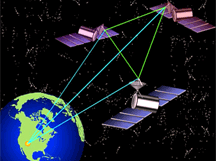 So assuming state-of-the-art digital signal processing, and satellites that are 100 times the size of those typically in use, all that remains is to triangulate the location of the transmitter. Typically three measurements are required in order to triangulate the location of an object. All the UK Sky TV satellites are in the same orbital position, but this would not give the level of diversity required and so satellites in other positions would need to be used in addition to the fleet used for the UK services. But as there are Sky TV services for other countries on other satellites in diverse orbital positions, these could be used. This bit, at least, is vaguely feasible.
So assuming state-of-the-art digital signal processing, and satellites that are 100 times the size of those typically in use, all that remains is to triangulate the location of the transmitter. Typically three measurements are required in order to triangulate the location of an object. All the UK Sky TV satellites are in the same orbital position, but this would not give the level of diversity required and so satellites in other positions would need to be used in addition to the fleet used for the UK services. But as there are Sky TV services for other countries on other satellites in diverse orbital positions, these could be used. This bit, at least, is vaguely feasible.
So with a fleet of gigantic, super-powerful, mega-satellites, it might just be possible to identify the location of a mobile phone from space. It is more likely, however, that the idea that 'pinging' a phone to locate it by satellite is pure hogwash, and is an idea espoused by the press to scare celebrities and others (like you and me) into thinking that they can be tracked down when up to no good!

 As it couldn't have been GPS, the most obvious solution is that the satellites used to deliver Sky television are not just 'Sky satellites' but 'spy satellites' too! For this to work, the satellites concerned would have to be able to receive a signal from the phone being tracked, identify the direction from which the signal was being received, and then triangulate this through measurements from a number of different locations.
As it couldn't have been GPS, the most obvious solution is that the satellites used to deliver Sky television are not just 'Sky satellites' but 'spy satellites' too! For this to work, the satellites concerned would have to be able to receive a signal from the phone being tracked, identify the direction from which the signal was being received, and then triangulate this through measurements from a number of different locations.  Let's take these one at a time. A geostationary satellite can 'see' about a third of the surface area of the earth. The image on the right shows the view from a satellite sat directly above the Greenwich Meridian. This puts it in clear line-of-sight of at least a third of the Earth's population (and probably more given that the pacific area is largely empty). So could it 'see' a mobile phone in the UK, yes! However, it would also see around a billion other mobile phones. Even if it had a very sharp 'spot beam' focussed solely on the UK (and remember that some celebrities may not be in the UK when pinged) it would still see probably a hundred million phones. Identifying the particular one being used by a certain individual is therefore not at all straightforward. Modern digital signal processing might be able to help a little, but with millions of mobile phones all transmitting at the same time, right across the country, it would take an awful lot of processing to pinpoint just one phone.
Let's take these one at a time. A geostationary satellite can 'see' about a third of the surface area of the earth. The image on the right shows the view from a satellite sat directly above the Greenwich Meridian. This puts it in clear line-of-sight of at least a third of the Earth's population (and probably more given that the pacific area is largely empty). So could it 'see' a mobile phone in the UK, yes! However, it would also see around a billion other mobile phones. Even if it had a very sharp 'spot beam' focussed solely on the UK (and remember that some celebrities may not be in the UK when pinged) it would still see probably a hundred million phones. Identifying the particular one being used by a certain individual is therefore not at all straightforward. Modern digital signal processing might be able to help a little, but with millions of mobile phones all transmitting at the same time, right across the country, it would take an awful lot of processing to pinpoint just one phone.Let's assume (for the sake of argument) that such processing could be fitted to a satellite and that it was possible to pick out one phone from amongst millions. The next job is to identify the direction of the signal from that phone. In order to do this to an accuracy of, say 1km, from geostationary orbit, requires an angular accuracy of about 0.01 degrees. To get this level of focus requires an antenna array that is approximately 1km across, nearly 100 times the maximum size of antennas fitted to current communication satellites.
 So assuming state-of-the-art digital signal processing, and satellites that are 100 times the size of those typically in use, all that remains is to triangulate the location of the transmitter. Typically three measurements are required in order to triangulate the location of an object. All the UK Sky TV satellites are in the same orbital position, but this would not give the level of diversity required and so satellites in other positions would need to be used in addition to the fleet used for the UK services. But as there are Sky TV services for other countries on other satellites in diverse orbital positions, these could be used. This bit, at least, is vaguely feasible.
So assuming state-of-the-art digital signal processing, and satellites that are 100 times the size of those typically in use, all that remains is to triangulate the location of the transmitter. Typically three measurements are required in order to triangulate the location of an object. All the UK Sky TV satellites are in the same orbital position, but this would not give the level of diversity required and so satellites in other positions would need to be used in addition to the fleet used for the UK services. But as there are Sky TV services for other countries on other satellites in diverse orbital positions, these could be used. This bit, at least, is vaguely feasible.So with a fleet of gigantic, super-powerful, mega-satellites, it might just be possible to identify the location of a mobile phone from space. It is more likely, however, that the idea that 'pinging' a phone to locate it by satellite is pure hogwash, and is an idea espoused by the press to scare celebrities and others (like you and me) into thinking that they can be tracked down when up to no good!

Sunday 30 May, 2010, 14:23 - Much Ado About Nothing
Posted by Administrator
Posted by Administrator
 Travelling on the London Underground last week, Wireless Waffle was intrigued by an advertisement for GiffGaff which marketed itself as 'the mobile network run by you'. Visions of self installed cell sites connected back to the network infrastructure by home (or business) broadband connections flashed in front of the eyes. Notions of a new style of organic mobile network where coverage is provided by the users themselves caused a twitch of our technology antennae.
Travelling on the London Underground last week, Wireless Waffle was intrigued by an advertisement for GiffGaff which marketed itself as 'the mobile network run by you'. Visions of self installed cell sites connected back to the network infrastructure by home (or business) broadband connections flashed in front of the eyes. Notions of a new style of organic mobile network where coverage is provided by the users themselves caused a twitch of our technology antennae. Sadly, upon visiting the GiffGaff web-site it turns out to be yet another Mobile Virtual Network Operator (MVNO) like Virgin Mobile, Tesco Mobile and others - and in this case, one which uses O2's mobile network. The 'network run by you' is simply an incentive to get you to get your friends to use GiffGaff SIM cards, a marketing ploy and not a new kind of network at all.
But would it be possible to construct a 'network truly run by you'? Believe it or not, the technology to do this already exists:
Firstly, there are phone handsets which use a WiFi connection to connect to the Internet and then using a suitable service provider, act as extended range cordless phones. They are extended in that if you take them with you to another place where there is a suitable WiFi connection, they log back on to the network and enable you to make and receive calls. Unlike a true mobile service, however, there is no hand-over between WiFi connections meaning that if you move in or out of coverage the call you are making will drop out. But with a WiFi phone you can sit in a coffee shop and make and receive calls as if you were at home - whether or not there is really any value in doing this when you could use an everyday mobile phone is a moot point.
In Japan and some other Asian countries, there is a mobile phone technology known as the Personal Handyphone System (PHS for short) which is technologically similar to the DECT digital cordless phones used in Europe. PHS (and it's 3G variant known as XGP) use short range, cordless phone like base stations which connect back to a central newtork control centre via a standard telecommunications connection (historically an ISDN circuit). The resulting network is similar to that of WiFi phones in that you have a home cordless phone, but which you can take with you to other houses where coverage exists (eg other PHS subscribers). The main difference between PHS and WiFi phones is that there is proper hand-over between cells such that you can walk down a street where there is PHS coverage and continue to make your call. Indeed, by adding a few cell sites at key locations and relying on users to extend coverage by their home connections, reasonably large coverage has been achieved without the operator needing to put expensive cell sites everywhere. One of the main problems of PHS is that cell sizes are relatively small due to the low power nature of the technology, but no smaller than that of a WiFi connection. It is now also rather antiquated technology and it is not clear whether operators will upgrade to XGP or some other technology - PHS subscriber numbers are on the decline.
 More recently there has been a development typified by services such as Vodafone's Sure Signal. These are miniature cell sites known as 'femto cells' which plug into your broadband connection and provide (in this case) 3G coverage in the immediate area. Having a 3G cell site in your house (or office) gets around the problem of coverage blackspots in a big way. Femto cells are fully working parts of the mobile network to which they are connected and therefore you can seamlessly roam in and out of coverage as you leave home (as indeed you can with PHS). 3G femto cells allow you to use your 3G phone or data card at home and in nearby areas.
More recently there has been a development typified by services such as Vodafone's Sure Signal. These are miniature cell sites known as 'femto cells' which plug into your broadband connection and provide (in this case) 3G coverage in the immediate area. Having a 3G cell site in your house (or office) gets around the problem of coverage blackspots in a big way. Femto cells are fully working parts of the mobile network to which they are connected and therefore you can seamlessly roam in and out of coverage as you leave home (as indeed you can with PHS). 3G femto cells allow you to use your 3G phone or data card at home and in nearby areas.Now... imagine a situation where a whole street had installed femto cells such that there was unbroken coverage as you walked or drove along it. There would be no need for coverage provided by any official network operator. In this case all the network coverage would be provided by the users. All that would be required would be some organisation to provide the central functions such as allocating phone numbers and managing mobility (handing over calls between cells) and hey presto! - truly a 'network run by you'. The only thing stopping anyone from launching such a service is lack of (harmonised) radio spectrum. In theory, someone could launch a 'network run by you' in the same, unlicensed spectrum, used by WiFi devices but the handsets they would need would be proprietary and thus expensive. If they could roll-out 3G femto cells instead, the handsets would be available off the shelf. But all of the 3G frequencies have already been assigned to licensed operators who are, in no way, going to allow some upstart to usurp some of their valuable spectrum.
 Which is kind of where organisations such as Google and Microsoft step up to the lectern with their desire to operate 'WiFi 2.0' in spectrum known as whitespace. Whitespace spectrum is that which lives inbetween terrestrial television transmitters but which cannot be used for more television without causing interferenece. It could be used for lower power short-range services though - such as femto cells for example. So combine the idea of femto cells, widely available, licence-free spectrum with big money backers, and perhaps the concept of a network 'run by you' is closer than might have first been apparent.
Which is kind of where organisations such as Google and Microsoft step up to the lectern with their desire to operate 'WiFi 2.0' in spectrum known as whitespace. Whitespace spectrum is that which lives inbetween terrestrial television transmitters but which cannot be used for more television without causing interferenece. It could be used for lower power short-range services though - such as femto cells for example. So combine the idea of femto cells, widely available, licence-free spectrum with big money backers, and perhaps the concept of a network 'run by you' is closer than might have first been apparent.Monday 19 November, 2007, 11:53 - Much Ado About Nothing
Posted by Administrator
For the past few months, every evening around sunset, my (ADSL) broadband connection at home has been 'drying up'. By this, I mean that the throughput has got smaller and smaller until eventually there has been no incoming or outcoming bandwidth available at all. If left alone, after an hour or two, the situation tends to correct itself but with sunset currently occuring during the working day, it's annoying to lose internet connectivity at these times.Posted by Administrator
At first I thought the problem might be to do with my ISP, Sky Broadband, but a quick scan of the rather useful, but unofficial, Sky User Forums didn't seem to indicate that others were suffering the same problems as me (though there were one or two veiled comments about how the connection sometimes dropped at night).
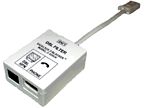 My next thought turned to my home installation. I'm quite a way from the local exhange and as such only get a connection speed of approximately 4 Mbps downstream and more like 0.4 Mbps upstream. According to my router, the available signal to noise ratio on the downstream link is only 8dB, that is to say that the ADSL signal on my phone line is only approximately 2.5 times higher than the noise on the line which isn't a great deal. But fiddling around with filters and connections makes next to no difference and the connection remains resolutely poor. During the 'dry periods' the signal to noise falls to 3dB or less (hence the loss of the connection), but re-booting the modem at these times oddly yields a return to 8dB.
My next thought turned to my home installation. I'm quite a way from the local exhange and as such only get a connection speed of approximately 4 Mbps downstream and more like 0.4 Mbps upstream. According to my router, the available signal to noise ratio on the downstream link is only 8dB, that is to say that the ADSL signal on my phone line is only approximately 2.5 times higher than the noise on the line which isn't a great deal. But fiddling around with filters and connections makes next to no difference and the connection remains resolutely poor. During the 'dry periods' the signal to noise falls to 3dB or less (hence the loss of the connection), but re-booting the modem at these times oddly yields a return to 8dB.Being a radio engineer type, and knowing that ADSL uses radio frequencies, I began to wonder whether the problem might be to do with increased radio interference on the line around sunset. ADSL uses frequencies from approximately 26 to 138 kHz for the upstream connection (i.e. from the home to the exchange) and in the range 138 kHz to 1104 kHz for the downstream connection (from the exchange to the home), though this frequency range is extended to just over 2200 kHz for the faster ADSL2+. Given my distange from the exchange, my connection is resolutely ADSL only (and not ADSL2+) and therefore if there was an increase in interference it would need to be in the frequency range 138 to 1104 kHz. However, as most ADSL modems are capable of running ADSL2+ even if the line is not capable of supporting it, it is likely that the receivers in them are not filtering out unwanted or unused frequencies making them susceptible to interference on frequencies up to 2200 kHz and quite possibly even higher even if those frequencies are not in use.
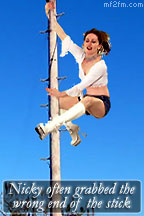 Now as it happens, this frequency range is home, in Europe, to both long wave and medium wave radio transmitters (in the frequency range 148.5 to 285.5 kHz and 526.5 to 1606.5 kHz respectively) and there are many high powered radio transmitters in this frequency range. Could it be that the propagation that exists around sunset causes such a significant rise in the level of signals in this frequency range that it was knocking out my ADSL connection? The telephone connections in my area are via flown cables between telegraph poles (as they are still called despite telegraph having died out eons ago) and as such probably make rather good aerials, so it is quite possible that my modem is susceptible to incoming interference from high power long and medium wave broadcast transmitters.
Now as it happens, this frequency range is home, in Europe, to both long wave and medium wave radio transmitters (in the frequency range 148.5 to 285.5 kHz and 526.5 to 1606.5 kHz respectively) and there are many high powered radio transmitters in this frequency range. Could it be that the propagation that exists around sunset causes such a significant rise in the level of signals in this frequency range that it was knocking out my ADSL connection? The telephone connections in my area are via flown cables between telegraph poles (as they are still called despite telegraph having died out eons ago) and as such probably make rather good aerials, so it is quite possible that my modem is susceptible to incoming interference from high power long and medium wave broadcast transmitters. When first booted up, the ADSL modems at both the exchange and the home end 'train', that is to say that they check all the available frequencies to see which have the best signal to noise and then use just these frequencies for the connection. This would perhaps explain why re-booting the modem during a dry period restores the signal to noise: clearly the frequency on which the interference occurs is one which is clean in the mornings when the modem is first switched on.
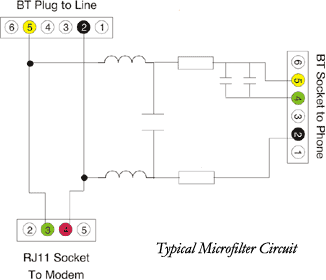 As yet I have not been able to confirm my theory that interference from high power broadcast transmitters is knocking out my broadband connection, but it does seem eminently reasonable. Next steps are to do some tests (maybe connect a receiver to the phone line - bearing in mind it has 50 Volts on it!) Another option might be to add some filtering to the incoming line: surprisingly ADSL microfilters do not touch the ADSL frequency range they just stop the ADSL signal getting into/out of any phones connected (see the example circuit diagram on the right), which means, incidentally, that if you have nothing other than an ADSL modem connected to any phone socket in your house, you don't need a microfilter on it: you only need microfilters on the sockets where phones are connected. Perhaps, therefore, there's room for an improved microfilter that cleans up the incoming ADSL connection as well as keeping it out of the phones. I'll keep you informed of any progress - and if you experience these problems yourself leave a comment and I'll update you personally if I make any breakthroughs!
As yet I have not been able to confirm my theory that interference from high power broadcast transmitters is knocking out my broadband connection, but it does seem eminently reasonable. Next steps are to do some tests (maybe connect a receiver to the phone line - bearing in mind it has 50 Volts on it!) Another option might be to add some filtering to the incoming line: surprisingly ADSL microfilters do not touch the ADSL frequency range they just stop the ADSL signal getting into/out of any phones connected (see the example circuit diagram on the right), which means, incidentally, that if you have nothing other than an ADSL modem connected to any phone socket in your house, you don't need a microfilter on it: you only need microfilters on the sockets where phones are connected. Perhaps, therefore, there's room for an improved microfilter that cleans up the incoming ADSL connection as well as keeping it out of the phones. I'll keep you informed of any progress - and if you experience these problems yourself leave a comment and I'll update you personally if I make any breakthroughs!Update: 18 Dec 2007 Forcing the modem to use ADSL instead of ADSL2+ whilst reducing the connection speed by less than about 5% has almost eradicated the problem. It seems that purposefully avoiding the use of frequencies above 1.1 MHz does make a worthwhile difference.
Update: 11 Feb 2012 After much messing about Wireless Waffle has designed a filter which cures the ADSL drop-out problem that is described above. It costs next to nothing and can be made in minutes!


